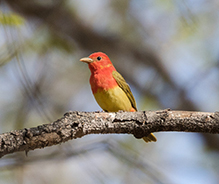Summer Tanager
(Piranga rubra)
Conservation • Description • Habitat • Ecology • Distribution • Taxonomy
Conservation Status |
|||
| IUCN Red List | LC - Least Concern |
||
| NatureServe | N5B - Secure Breeding SNA - Not applicable |
||
| Minnesota | not listed |
||
Description
Summer Tanager is a colorful medium-sized bird. There are two subspecies, both occurring in the United States. Eastern Summer Tanager summers in southeastern U.S. and winters in Brazil and northwestern Bolivia. It is found in open deciduous woodlands, especially woodlands with oak or hickory. Western Summer Tanager summers in southwestern U.S. and northern Mexico, and it winters in Baja California and southern Mexico. It is found in riparian woodlands with cottonwoods and willows.
Summer Tanagers are rare migrants to Minnesota. Both subspecies are often seen in orchards, parks, roadside trees, and residential areas near their usual woodlands. In the summer, they are sometimes attracted to backyard fruit feeders with orange or banana. In early spring and fall they sometimes come to suet feeders.
Adults feed mostly on insects, especially bees and wasps, but also on berries and small fruits.
Adults are 7″ to 7¾″ (18 to 20 cm) in length and have a 12″ (30 cm) wingspan. The body is robust. Like other tanagers, for whom they are misnamed, and other cardinals, to whom they are more closely related, male and female Summer Tanagers have very different coloration.
The male is bright rosy red overall year-round. The head has a slight crest.
The female has grayish green to greenish yellow upper parts and dusky yellow underparts. It sometimes has an orange wash overall.
The immature male in the spring of its first year is greenish yellow with patchy red, including a red head.
Western Summer Tanager has longer wings, a longer tail, and longer legs, and the bill is slightly longer. The overall coloration is paler, and the nape and rump contrast more sharply with the back.
Size
Total length: 7″ to 7¾″ (18 to 20 cm)
Wingspan: 12″ (30 cm)
Voice
The call is a series of three short whistled notes, sounding like pit-a-tuk.
The male song is a series of three to five whistled phrases separated by pauses, sounding like an American Robin but faster.
Similar Species
Scarlet Tanager (Piranga olivacea) overall color is a more intense scarlet. The wings and tail are black.
Habitat
Open mixed woodlands, riparian woodlands, and pine woodlands
Ecology
Migration
Late April to late May and August through October
Nesting
Summer Tanager does not normally nest in Minnesota. However, the Minnesota Ornithologists’ Union shows it commonly nesting in Scott and Dakota Counties.
Food
Mostly insects, especially bees and wasps, but also berries and small fruits
Distribution
Occurrence
Rare migrant to southern Minnesota, erratic to the North Shore
Maps
The Minnesota Ornithologists’ Union All Seasons Species Occurrence Map
Taxonomy
Class
Aves (birds)
Order
Passeriformes (perching birds)
Family
Cardinalidae (cardinals and allies)
Genus
Piranga (northern tanagers)
Family
The genus Piranga was formerly placed in the tanager family Thraupidae. Mitochondrial DNA data from several studies between 1997 and 2007 show that the genus is more closely related to cardinals (family Cardinalidae).
Subordinate Taxa
Eastern Summer Tanager (Piranga rubra ssp. rubra) ![]()
Western Summer Tanager (Piranga rubra ssp. cooperi) ![]()
Synonyms
Fringilla rubra
Pyranga aestiva
Tanagra rubra
Visitor Photos
Share your photo of this bird.
This button not working for you?
Simply email us at info@MinnesotaSeasons.com.
Attach one or more photos and, if you like, a caption.
|
||
Todd Mitchell |

|
MinnesotaSeasons.com Photos
|

Slideshows

Visitor Videos
Share your video of this bird.
This button not working for you?
Simply email us at info@MinnesotaSeasons.com.
Attach a video, a YouTube link, or a cloud storage link.
Other Videos
Summer Tanager (Piranga rubra)
Birds In Motion
Summer Tanager Piranga rubra
Just Birds
Summer Tanager, Piranga rubra
Laurie Nessel


